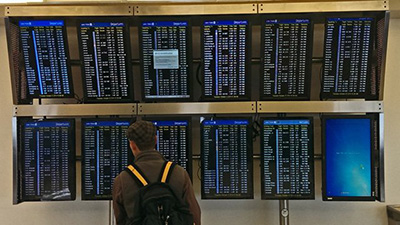Digital Signage and the ‘Blue Screen of Death’
 By Jeff Hastings
By Jeff Hastings
CEO, BrightSign
I’ve been noticing an amusing trend emerge of late — people posting images to Pinterest and other social networks, documenting digital signage gone awry. In most cases, these images depict a once-impressive digital signage installation brought to its knees by what’s well known in PC circles as the “Blue Screen of Death.”
No doubt these images are striking, but candidly I worry that these images unfairly cast a shadow on the entire digital signage industry, when certain segments have never and will never fall victim to the Blue Screen of Death. I’ll circle back to that theme at the conclusion of this post, but in the meantime I’ll offer some perspective on how 4K is evolving our industry in unexpected ways.
4K is proving to be a turning point in our industry, because it marks the point at which dedicated solid-state signage players are starting to pull ahead of PCs in terms of functionality and performance. In the latest research report on the World Market for Digital Signage, IHS predicts that “media players will demonstrate stronger growth potential in future years than PCs, as many companies are launching appliance-based media players with similar functionality and longevity, at a noticeably lower cost, than traditional PCs.”
Let’s take a look at why this is the case:
First, the graphics engine and CPU in high-end solid-state players are now more powerful than those in all but the most expensive PCs. Not only can they decode 4K H.265-encoded video at 60p, but they also deliver interactive, full-screen HTML5 content or a multitude of sophisticated HTML5 assets simultaneously. We’re finding that 4K players are being used to play back conventional 1080p content with sophisticated HTML5 and other dynamic elements, due to the richer experience they provide. There are PCs with advanced graphics cards that can match this performance, and there are also very compact PCs that use relatively little power. However, there are none that provide both, and match the cost or the reliability of the equivalent purpose-built player.
Secondly — and this is nothing new — any integrator or store operator will attest to the fact that reliability is as key to the success of a digital signage installation as compelling content. There’s absolutely no reason to approve the effort and expense of a digital signage installation if the content doesn’t compel the customer to buy, or if the screen doesn’t reliably display this content — in some cases 24/7. This is another key reason why purpose-built, solid-state media players that have no moving parts will continue to pull ahead of PCs in 2015.
And lastly, the perceived wisdom has been that a PC is required for large and complicated installations, but that is no longer true. Spectacular results have been achieved on large video walls, outdoor LED displays and mass stadium and retail rollouts driven by the new generation of dedicated players offering advanced capabilities and total reliability.
As this perceived wisdom is overturned, we should start to see a reduction in the number of high-profile “Blue Screens of Death” that I mentioned previously. We can expect the digital signage industry to move past this disappointing era; onward and upward to a better place where we’ve eliminated the Blue Screen of Death in digital signage.
This column was reprinted with permission from the Digital Screenmedia Association and originally appeared here.





